|
|
| (1) Posted by Michael McDowell [Monday, Aug 11, 2008 21:36] |
Forgotten Whyatt problem?
One for our Australian friends. A Bill Whyatt problem which does not feature in Bob Meadley’s collection.
Not vintage Whyatt, but still worth solving.
W.A.Whyatt
362 The South African Chessplayer, May 1961
 (= 11+11 ) (= 11+11 )
Mate in 3
|
|
| (2) Posted by Geoff Foster [Tuesday, Aug 12, 2008 00:23] |
In a letter to me dated 22 May 1980, Bob Meadley said "Jim Jones found another Whyatt problem from the South African Chess Player dated May 1961. It's number 362". Bob then quoted the above diagram. Bob then continued "I found this one in the Sunday Telegraph 27 August 1961".
 (= 8+5 ) (= 8+5 )
#2
The Sunday Telegraph is a Sydney newspaper.
|
|
| (3) Posted by Michael McDowell [Tuesday, Aug 12, 2008 08:47] |
Thanks for posting that one Geoff. A complete block with three tries failing to pinning defences - it's a little beauty. Definitely published in the wrong place!
|
|
| (4) Posted by Geoff Foster [Wednesday, Aug 13, 2008 00:44] |
The full solution is:
1.Ka4? Bc6! (2.Qc4?)
1.Kb4? Rb8! (2.Qd7?)
1.Kb2? Bxd4! (2.c4?)
1.Ka2!
1... R~ 2.Qd7
1... Rd6 2.c6
1... Bc6 2.Qc4
1...Bb7 2.Qxb7
1...Bf~ 2.Se7
1... Bxd4 2.c4
1... g4 2.Sf4
There are also incidental tries with a changed mate:
1.Qb6? (2.Qe6)
1... Rd6,Re8 2.Qd6
1... Bxd4 2.c4
1... Bc6!
1.Qa6? (2.Qe6)
1... Rd6,Re8 2.Qd6
1... Bc6 2.Qc4
1... Bxd4!
The problem shows 3 self-pinning tries, with 3 self-blocks, a battery mate and superb construction. Note how the black pawn on g5 and black rook on d8 block the bishop.
No doubt the problem was published where it was because of a lack of originality. It is clearly inspired by the following famous problem (composed at the Piran Congress 1958), which shows 4 self-pinning tries in a much heavier setting.
C Mansfield, W Massmann & L Loshinski
3rd Prize, Problem, 1959
 (= 12+9 ) (= 12+9 )
1.Kg3,Kh2? Bd6! (2.Qf3?)
1.Kh3? Bxe6! (2.Bf3?)
1.Kf1? Qf7! (2.Qe5?)
1.Kg1? Bxd4! (2.e4?)
1.Kh1!
|
|
| (5) Posted by Michael McDowell [Wednesday, Aug 13, 2008 08:46] |
The theme goes back to at least Niemeijer in 1919, and continued to have a life post-Whyatt. van Dijk even won a 1st Prize in 1966 with a 4-fold example.
This is the best example I have seen of the idea, because of the superb and wholly natural construction which you explain. Overall artistry comes ahead of crude number-counting (4 is better than 3) in my book.
It's strange that he didn't keep a record of the problem. It would have made a grand addition to Bob's book.
|
|
| (6) Posted by Jan Hein Verduin [Wednesday, Aug 13, 2008 19:46] |
The problems of Niemeijer, Mansfield/Massmann/Lohinski and Van Dijk have the additional feature -that Whyatt hasn't- of being a complete block where the white King has 8 squares to choose from, and none of them is defeated by check, something called the Le Lionnais theme (after a French problemist who collected problems with this idea). A problem by M. Duchateau from 1884 is quoted as being the oldest example, but that one has no pins at all. Mansfield et al were after four tries defeated by pins, which explains the somewhat heavy construction.
|
|
| (7) Posted by David Knezevic [Wednesday, Aug 13, 2008 19:54] |
Actually, problem by Whyatt is a complete block.
As far as I remember (but I allow that I may be wrong) in Le Lionnais theme the white king must be mirrored, which is not so in van Dijk's problem. By the way, it hasn't been quoted yet in this thread...
N. G. G. van Dijk
1st Pr BABY Theme Tourney 1964-66
 (= 7+12 ) (= 7+12 )
#2
|
|
| (8) Posted by Vladimir Tyapkin [Thursday, Aug 14, 2008 02:52] |
To complete the set:
Niemeijer's problem with three tries, mentioned before by Michael McDowell:
M.Niemeijer
Tijdschrift, 1919, 2nd prize
 (= 6+8 ) (= 6+8 )
#2
1.Ka4!, 1.Ka3(b4)? Bf8!, 1.Kc4(c3,c2)? Rc6!, 1.Ka2(b2,c2) Rh2!
I was able to find earlier problem by A. Mackenzie with two tries. By the way, my copy of "Chess Lyrics" belonged to N. van Dijk!
A.Mackenzie
2nd HM, Seventh Tourney, Otago Witness, 1900
 (= 9+8 ) (= 9+8 )
#2
1.Kh1!, 1.Kh3? Bc8!, 1.Kg1? Bd4!
|
|
| (9) Posted by Michael McDowell [Thursday, Aug 14, 2008 08:47] |
Unlike the other examples the Mackenzie is an incomplete block, as the king must make the key to allow 1...Bf6 2.Qg2.
Still, it's a nice problem!
|
|
| (10) Posted by Michael McDowell [Wednesday, Apr 1, 2009 20:27] |
Another problem which is not in the Whyatt collection:
W.A.Whyatt
The Observer 1959 (version)
 (= 9+14 ) (= 9+14 )
Mate in 3
I’ll not add the solution in case anyone would like to solve.
A nice example of Whyatt’s quiet style, though the setting is a little heavy.
|
|
| (11) Posted by Jacques Rotenberg [Sunday, Apr 5, 2009 12:47] |
What does "version" means ? whose is it ? do you know ?
|
|
| (12) Posted by Michael McDowell [Monday, Apr 6, 2009 21:45] |
Sorry Jacques, I don't know exactly what it means.
I found the problem in a collection which John Ling produced a few years ago giving all the originals from the period (1955-67) when he edited the chess column in The Observer. It is marked "version" under the diagram, but the solution doesn't elaborate in any way.
|
|
| (13) Posted by Jacques Rotenberg [Monday, Apr 6, 2009 23:06] |
So, following what you say, it seems to be a version made by the author before 1967 !
|
|
| (14) Posted by Ian Shanahan [Wednesday, Apr 8, 2009 02:58] |
Like Michael, I found this problem (and then passed it on to Bob Meadley) some years ago within Volume 1 of John Ling's "Observer" collection. As I recall from Ling's text, Whyatt's original setting in the "Observer" was cooked; I'm fairly certain that this is a correction by Ling for his collection - and not one by Whyatt, because Whyatt would have noted it and it would have subsequently appeared in Bob Meadley's book. In any case, it's not vintage Whyatt. @Michael: Didn't I mention this problem to you on the phone before? (Rather remiss of me if I didn't!)
|
|
| (15) Posted by Michael McDowell [Wednesday, Apr 8, 2009 08:14] |
If you did Ian I don't remember. I posted it in case anyone who has Bob's book would like to note it for the sake of completeness.
I agree it's not vintage Whyatt.
|
|
| (16) Posted by Geoff Foster [Saturday, Jan 15, 2011 11:22]; edited by Geoff Foster [11-01-15] |
In Bob Meadley's book "W.A. Whyatt's Chess Problems", problem no.117 is cooked by 1.Bxf6. However, I've just discovered that the problem can be corrected by adding a wPh7, as below!
W.A. Whyatt, Problem 1964 (v)
 (= 10+15 ) (= 10+15 )
#3
1.h4! (2.Rxg5+ Kf4/fxg5 3.g3/Qxf7)
1...d3 2.Kxf7 Re5 3.Rf1
1...Se7 2.Rxe6 Re5 3.Rxf6
1...gxh4 2.Sg6 (3.Sxh4,Rf1)
The try 1.Kxf7? threatens 2.Qxe6#. The refutation 1...Re5! self-blocks e5 and so would seem to allow 2.Rf1#, but it has the compensating effect of opening the Ba6's line to f1. The try 1.Rxe6? threatens 2.Re1,Re2,Re3,Ree4,Re7#. The same refutation 1...Re5! this time would seem to allow 2.Rxf6#, but it has the compensating effect of pinning the Re6. After the key, the defences 1...d3 and 1...Se7 each close a line and so nullify the compensating effect, allowing White to proceed with the original plan. Whyatt, in correspondence with Alexander Goldstein, called this strategem "loss of compensation".
|
|
| (17) Posted by Per Olin [Saturday, Jan 15, 2011 11:32] |
Adding a white pawn on h7 means two captures by this pawn, but black has 15 pieces...
|
|
| (18) Posted by Joost de Heer [Saturday, Jan 15, 2011 12:45] |
Pb6 is superfluous.
|
|
| (19) Posted by Kevin Begley [Saturday, Jan 15, 2011 16:08]; edited by Kevin Begley [11-01-15] |
In fact, Pb6 would render this position illegal...
[err, already noted.]
|
|
| (20) Posted by Geoff Foster [Saturday, Jan 15, 2011 21:18] |
Thanks Joost! If the Pb6 is removed then the position is legal!
|
|
No more posts |
MatPlus.Net  Forum Forum  Threemovers Threemovers  Forgotten Whyatt problem? Forgotten Whyatt problem? |
 ISC 2024
ISC 2024 Forum
Forum  Threemovers
Threemovers  Forgotten Whyatt problem?
Forgotten Whyatt problem? 


